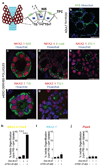Generation of functional thyroid from embryonic stem cells
- PMID: 23051751
- PMCID: PMC3687105
- DOI: 10.1038/nature11525
Generation of functional thyroid from embryonic stem cells
Abstract
The primary function of the thyroid gland is to metabolize iodide by synthesizing thyroid hormones, which are critical regulators of growth, development and metabolism in almost all tissues. So far, research on thyroid morphogenesis has been missing an efficient stem-cell model system that allows for the in vitro recapitulation of the molecular and morphogenic events regulating thyroid follicular-cell differentiation and subsequent assembly into functional thyroid follicles. Here we report that a transient overexpression of the transcription factors NKX2-1 and PAX8 is sufficient to direct mouse embryonic stem-cell differentiation into thyroid follicular cells that organize into three-dimensional follicular structures when treated with thyrotropin. These in vitro-derived follicles showed appreciable iodide organification activity. Importantly, when grafted in vivo into athyroid mice, these follicles rescued thyroid hormone plasma levels and promoted subsequent symptomatic recovery. Thus, mouse embryonic stem cells can be induced to differentiate into thyroid follicular cells in vitro and generate functional thyroid tissue.
Figures




Comment in
-
Thyroid function: functional thyroid gland grown in vitro offers intriguing therapeutic possibility.Nat Rev Endocrinol. 2012 Dec;8(12):693. doi: 10.1038/nrendo.2012.197. Epub 2012 Nov 13. Nat Rev Endocrinol. 2012. PMID: 23147584 No abstract available.
References
-
- De Felice M. Thyroid Development and Its Disorders: Genetics and Molecular Mechanisms. Endocrine Reviews. 2004;25:722–746. - PubMed
-
- De Felice M, Di Lauro R. Minireview: Intrinsic and Extrinsic Factors in Thyroid Gland Development: An Update. Endocrinology. 2011;152:2948–2956. - PubMed
-
- Mauchamp J, Mirrione A, Alquier C, Andre F. Follicle-like structure and polarized monolayer: role of the extracellular matrix on thyroid cell organization in primary culture. Biol Cell. 1998;90:369–380. - PubMed
-
- Nunez J, Pommier J. Formation of thyroid hormones. Vitam Horm. 1982;39:175–229. - PubMed
-
- Kimura S, et al. The T/ebp null mouse: thyroid-specific enhancer-binding protein is essential for the organogenesis of the thyroid, lung, ventral forebrain, and pituitary. Genes Dev. 1996;10:60–69. - PubMed
Publication types
MeSH terms
Substances
Grants and funding
LinkOut - more resources
Full Text Sources
Other Literature Sources
Molecular Biology Databases

